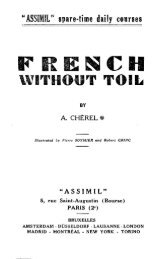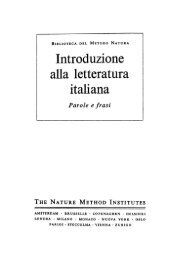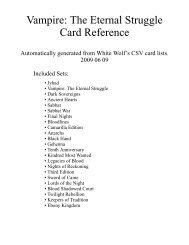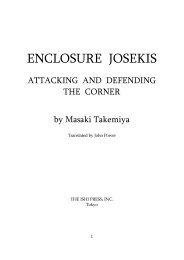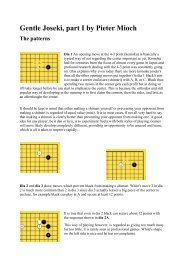Plains Cree: A Grammatical Study - Computer Science Club
Plains Cree: A Grammatical Study - Computer Science Club
Plains Cree: A Grammatical Study - Computer Science Club
Create successful ePaper yourself
Turn your PDF publications into a flip-book with our unique Google optimized e-Paper software.
50 WOLFART: PLAINS CREE [TRANS. AMER. PHIL. SOC.<br />
quency, they constitute only 4 per cent of all AI<br />
stems. 60<br />
In addition, the stems ending in clusters are as follows:<br />
5.51. Transitive Stems<br />
Approximate percentage<br />
of TI stems<br />
Transitive verb stems end in a non-syllabic or a<br />
cluster of non-syllabics, e.g.,<br />
hk<br />
sk<br />
ht<br />
0.4<br />
7.2<br />
21<br />
TA wdpam- 'see'<br />
st<br />
2.1<br />
pakamahw- 'strike'<br />
nipah- 'kill,' etc.;<br />
5.52. Animate Intransitive Stems<br />
TI wapaht- 'see'<br />
pakamah- 'strike'<br />
sakin- 'seize,' etc.<br />
TA and TI stems are followed by theme signs which<br />
are described in sections 5.42 and 5.71.<br />
Transitive animate (TA) verbs end in the following<br />
single non-syllabics:<br />
Approximate percentage<br />
of TA stems<br />
h 18.3<br />
m 17.2<br />
n 12.5<br />
s 0.07<br />
t 11.9<br />
w 24.6<br />
y<br />
0.35<br />
In addition, the stems ending in clusters are as<br />
follows:<br />
ht<br />
st<br />
hw<br />
mw<br />
pw<br />
spiv<br />
sw SW<br />
Approximate percentage<br />
of TA stems<br />
Transitive inanimate (TI) verbs end in the following<br />
single non-syllabics:<br />
h<br />
n<br />
s<br />
t<br />
0.76<br />
0.07<br />
11.1<br />
0.28<br />
0.07<br />
0.07<br />
2.7<br />
Approximate percentage<br />
of TI stems<br />
20.1<br />
22.7<br />
5.1<br />
21.4<br />
60Consider also Ellis's recent statement (1971: p. 84) that<br />
"most II stems end in /n/ but a few end in one of the vowels<br />
/i, e, a/." A:hile there may of course be dialect differences, a<br />
survey of over 700 II stems shows that vowel stems (in i, o, e, a)<br />
constitute fully two-thirds of all II stems, and that only one-third<br />
are n-stems.<br />
Animate intransitive (AI) verb stems end in a<br />
vowel or n, e.g.<br />
api- 'sit'<br />
wdpamiso- 'see oneself'<br />
tapasi- 'flee'<br />
pimohte- 'walk along'<br />
nipa- 'sleep'<br />
pasiko- 'get up'<br />
pimisin- 'lie.'<br />
The AI stem types follow:<br />
i<br />
0<br />
e<br />
a<br />
o<br />
n<br />
Approximate percentage<br />
of AI stems<br />
29.2<br />
25.4<br />
3.2<br />
27.4<br />
10.9<br />
0.03<br />
3.9<br />
e-stems have stem alternants in e and a. The<br />
alternant in a occurs in the non-third forms of the<br />
independent indicative and throughout the inde-<br />
pendent preterit; the alternant in e occurs elsewhere.<br />
(However, the distribution of the alternants is not<br />
entirely stable. Thus we find S14-3 ayamihdhkan<br />
(AI 2 delayed imperative), and T101-6 atoskdsiw<br />
(diminutive) beside T102pl acoskesiw.)<br />
n-stems have alternants in n and ni. The alternant<br />
in n occurs in the 3 and 3p forms of the independent<br />
and conjunct orders; the alternant with final ni is<br />
found in the first and second person forms of the<br />
conjunct order. All other instances of n followed by i<br />
are indeterminate since the i may reflect the suffix-<br />
initial /e/ or, in the case of imperative or derivational<br />
suffixes with an initial consonant, connective /i/.<br />
That the first and second person forms of the conjunct<br />
order actually have the ni-alternant rather than n<br />
plus connective /i/ follows from two observations:<br />
(1) These forms have the y-alternant of the suffixes<br />
(5.453) which normally occurs after vocalic stems or<br />
suffixes. (2) Lacombe cites parallel sets of forms with<br />
n and ni (pimisindn, pimisiniydn 'that I lie down') and<br />
Ellis (1971: p. 83) actually states the n-form to be<br />
more common in James Bay <strong>Cree</strong>. Thus, the histori-



